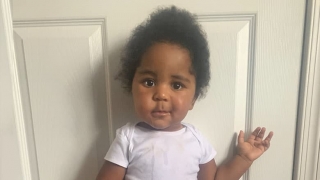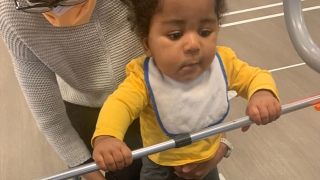Hassani’s Story: Hemispherotomy to Control Seizures from Hemimegalencephaly
Published on
Published on
Learning that their child has a brain condition was a traumatic experience for Samia and Andre. They want to share their son Hassani’s story to offer hope and help to other families who find themselves in the same situation.
 Hassani was just 1 week old when his parents, Samia and Andre, noticed him making strange movements with his arms and rolling his eyes. They took him to an emergency room near their home in Reading, Pa., where he was evaluated by four different doctors over the course of several hours. During most of the evaluation, his behavior seemed fine and didn’t raise any red flags for the doctors. It wasn’t until their final exam that a physician caught Hassani making the arm and eye movements.
Hassani was just 1 week old when his parents, Samia and Andre, noticed him making strange movements with his arms and rolling his eyes. They took him to an emergency room near their home in Reading, Pa., where he was evaluated by four different doctors over the course of several hours. During most of the evaluation, his behavior seemed fine and didn’t raise any red flags for the doctors. It wasn’t until their final exam that a physician caught Hassani making the arm and eye movements.
The physician was greatly concerned by what she saw and called Children’s Hospital of Philadelphia (CHOP) to consult the interdisciplinary Neuroscience Center team. The specialists at CHOP advised her to send the family to the CHOP Emergency Department immediately.
Shortly after the family arrived at CHOP, Hassani was admitted to the Neurology Unit. Samia and Andre were impressed with the skill and compassion of CHOP’s care team.
“The nurses were amazing,” says Samia of the care the team provided her newborn. “They were very gentle as far as handling him and compassionate. They went out of their way to make him comfortable.”
A magnetic resonance imaging (MRI) study determined that Hassani had left-sided hemimegalencephaly, a rare genetic condition in which part of the brain is abnormally larger than the rest. The condition causes seizures. An electroencephalogram (EEG) found that in just one hour, Hassani experienced more than 20 seizures.
Hassani was prescribed medication, and the family was discharged home. Once home, however, Hassani continued making strange movements, which his mom describes as “body crunches.” The crunches came in clusters of five to 10 at a time, and, as time went on, their frequency increased. It got to the point where Hassani was experiencing up to 200 crunches a day.
An evaluation at CHOP determined that the crunches were infantile spasms, a seizure disorder that affects babies. Diagnosing the spasms helped direct his care team toward the precise medication known to control them.
Early on in their care at CHOP, Samia and Andre had met with Attending Neurosurgeon and Director of Epilepsy and Functional Neurosurgery, Benjamin Kennedy, MD. Dr. Kennedy explained that sometimes in hemimegalencephaly, seizures don’t respond to medication. In those cases, there is a surgical procedure called a hemispherotomy, that can offer hope of lasting seizure control.
Dr. Kennedy explained the risks and benefits of the procedure and said that because the left hemisphere of the brain controls movement on the right side of the body, one side effect Hassani would experience after surgery was right-sided weakness. But Dr. Kennedy expected that with diligent physical and occupational therapy, function on the right side would gradually improve.
“We were skeptical at first because the thought of our infant having brain surgery was terrifying,” says Samia. “But we knew and understood that this was the best treatment option for Hassani and would give him the best possible quality of life.”
 At the time of their initial consultation with Dr. Kennedy, Hassani was very young and small. Thankfully, the CHOP team was able to control seizures with medication for several months while he grew larger, reducing the risk of surgery. When Hassani began to have what are known as breakthrough seizures that couldn’t be controlled by medication, the family and care team determined it was time for the hemispherotomy.
At the time of their initial consultation with Dr. Kennedy, Hassani was very young and small. Thankfully, the CHOP team was able to control seizures with medication for several months while he grew larger, reducing the risk of surgery. When Hassani began to have what are known as breakthrough seizures that couldn’t be controlled by medication, the family and care team determined it was time for the hemispherotomy.
As expected, after the procedure Hassani had right-sided weakness. But he has made progress every day since. He spent five days recovering in the intensive care unit, five days in CHOP’s specialized neurology unit, and four weeks in inpatient rehabilitation at CHOP’s Seashore House, and he was discharged home.
He hasn’t had a seizure since the procedure and is currently weaned off all medication. He is getting stronger every day, says his mom. He is learning to walk, loves playing with toys and waving “hi” to people, and is very chatty. He has made good progress with mobility in his right leg and continues to make progress with his right arm.
“Everything Dr. Kennedy told us is coming to light,” says Samia. “He said that Hassani would surprise us and that is exactly what he is doing. I can’t thank Dr. Kennedy enough. He’s changing lives.”
“When we first got the diagnosis, it felt like it was the end of the world,” she adds. “I felt cheated and worried about what kind of life he would have. It seemed like he wouldn’t be able to do things other kids could do. But the more we spoke to doctors at CHOP and Dr. Kennedy and read patient stories on the CHOP website, all that stuff helped. It gave us insight on the life that he could possibly have.”
“I want parents who may have a child with a condition similar to Hassani's to know that they can have faith in CHOP, that things can get better, and that you must speak up for your child because healthcare professionals have not seen every medical situation or condition.”
“Every person is different and as a parent, you must have a voice for your child. I hope that his condition and his story can help provide hope and optimism to the next family,” she says.